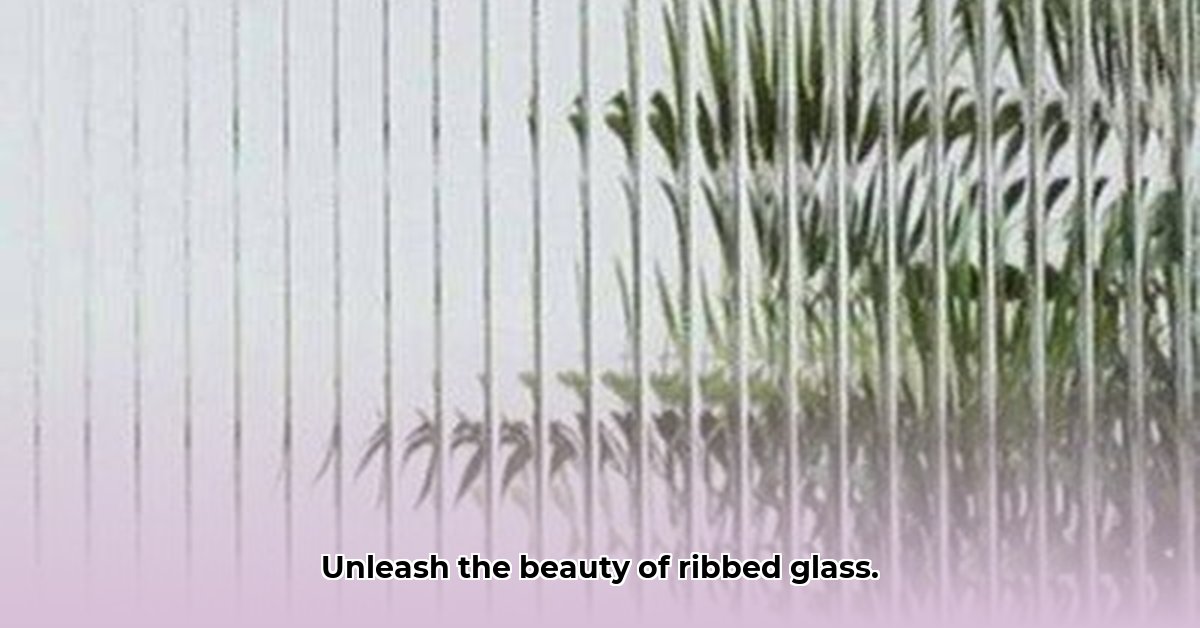Ever wondered about the textured glass you see in stylish interiors? Fluted, reeded, and ribbed glass all add character, but understanding their subtle differences is key to achieving the perfect look. This guide will clarify the distinctions and help you choose the right glass for any project, from home renovations to commercial builds. We’ll explore manufacturing, light transmission, privacy, applications in furniture, lighting, and architectural design, ensuring you make informed and eco-conscious decisions. For more on lighting applications, check out these replacement glass shades. Is incorporating these textured elements the design upgrade your space needs?
Ribbed Glass: A Designer’s Guide
Ribbed glass is more than just a visually appealing pattern; it’s a design element with unique properties. It provides visual interest while gently diffusing light and obscuring direct visibility, enhancing privacy without sacrificing brightness. Let’s dive into its characteristics and explore how to integrate it into your projects for stunning results, differentiating it from similar glass types. Whether you’re working on a residential makeover or a commercial construction, understanding the nuances of ribbed glass will empower you to make confident design choices.
Understanding the Different Types of Textured Glass: Fluted vs Reeded vs Ribbed
The terms “ribbed,” “fluted,” and “reeded” are often used interchangeably, leading to confusion. While all three feature textured surfaces, distinguishing them is essential. Reeded glass features fine, delicate lines, like a soft etching, offering a subtle texture and moderate light diffusion. Fluted glass features slightly deeper, wider grooves than reeded glass, providing a more pronounced texture and increased light refraction. Ribbed glass boasts the most pronounced, deeply recessed ridges, creating a bolder visual statement and offering the highest level of privacy among the three. These variations significantly impact light diffusion and the overall aesthetic. Choosing the right texture is crucial for achieving your desired design outcome.
How Textured Glass Is Made and What Makes It Special: Light Transmission and Privacy
All three types of textured glass—ribbed, fluted, and reeded—begin with molten glass poured into a mold or passed through rollers that imprint the desired pattern. The mold’s design or roller pattern, particularly the depth and spacing of the channels, is where the magic happens. Ribbed glass molds have the deepest and widest channels, creating a dramatic effect on light refraction and scattering, resulting in a richer play of light and shadow. This also enhances privacy, as deeper grooves obscure vision while still allowing diffused light to filter through. The thickness of the glass, rather than the texture itself, also contributes to its strength and safety. Thicker glass equates to increased durability and impact resistance. Tempered versions offer even greater strength and shatter resistance.
Light, Privacy, and Your Design Vision: Balancing Functionality and Aesthetics
When choosing between ribbed, fluted, or reeded glass, carefully consider the desired light and privacy levels. Ribbed glass, with its deeper texture, generally offers more privacy while still allowing soft, diffused light. It’s excellent for spaces where you want to minimize direct visibility without completely blocking natural light. If maximum light transmission is essential, reeded glass might be a better choice, allowing more light to pass through with only a slight diffusion. Fluted glass offers a middle ground, balancing light and privacy. Remember, thickness plays a role – thicker glass typically means more privacy and slightly less light transmission. Finding the right balance is key to achieving your design vision.
Where Ribbed Glass Shines: Applications in Architecture and Design
Ribbed glass is incredibly versatile, offering numerous applications in both residential and commercial spaces. Imagine a textured shower enclosure transforming a bathroom into a spa-like retreat, with light dancing along the walls. Envision a sophisticated partition in a commercial setting, creating semi-private workspaces while maintaining an open feel. Consider it as a unique design detail in custom furniture, like cabinet doors or tabletops, adding a touch of elegance and texture. It can also be used for a striking office door, creating a memorable entrance that balances privacy and aesthetics. Its vintage aesthetic works in retro-inspired projects, while its clean lines suit modern designs. The possibilities are limited only by your creativity. Ribbed glass is also used increasingly in lighting fixtures, where the texture creates interesting patterns and diffused light.
Choosing the Right Glass: A Simple Guide For Your Project
Here’s a handy table to help you decide which textured glass best suits your needs:
| Glass Type | Groove Depth | Light Transmission | Privacy Level | Aesthetic | Ideal Uses |
|---|---|---|---|---|---|
| Reeded | Very Shallow | High | Low | Clean, Minimalist | Office partitions, modern interiors, windows, lighting fixtures |
| Fluted | Moderate | Moderate | Moderate | Transitional, Elegant | Doors, room dividers, decorative accents, furniture |
| Ribbed | Deep | Moderate to Low | High | Textured, Dramatic | Shower enclosures, feature walls, furniture, commercial spaces |
Sustainability, Cost, and Making Responsible Choices in Glass Selection
All types of glass are recyclable, making them environmentally friendly. However, the manufacturing process of ribbed glass, with its deeper grooves, might use slightly more energy and materials than reeded or fluted glass. It’s essential to inquire about the manufacturer’s sustainability practices, such as using recycled glass (cullet) in the production process. Ribbed glass is generally slightly more expensive due to its more complex manufacturing and the added material required. This added cost often translates to a unique design feature that elevates the overall aesthetic and value of your project. Making informed choices about materials and processes contributes to sustainable design.
Final Thoughts: Informed Decisions Lead to Stunning Results with Ribbed Glass
Choosing textured glass is about understanding how each type influences light, privacy, and the overall design aesthetic. By carefully considering light transmittance, desired privacy, and your budget, you can confidently integrate these versatile materials into your project. The perfect choice depends entirely on your specific goals and the impression you wish to create. Experiment and be bold! Ribbed glass offers a unique opportunity to add depth, texture, and sophistication to any space.
How to choose between fluted, reeded, and ribbed glass for architectural projects: A Comprehensive Guide
When specifying glass for architectural projects, precise terminology is crucial due to inconsistent market definitions. The choice depends on desired aesthetics, light diffusion, privacy needs, and budget. Manufacturing processes influence properties; understanding these processes ensures you make the best choice for your project. Key takeaways to consider are the environmental impact and the need for sustainable practices in glass selection.
Key Takeaways:
- Fluted, reeded, and ribbed glass all offer textured surfaces, but their patterns and resulting effects differ.
- The choice depends on desired aesthetics, light diffusion, privacy needs, and budget.
- Manufacturing processes influence properties; understand these to make the best choice for your project.
Understanding the Differences: Fluted, Reeded, and Ribbed Glass in Detail
Let’s clarify the often-confused terminology. While frequently used interchangeably, “fluted,” “reeded,” and “ribbed” glass each possess unique characteristics. Think of it like choosing between subtle stripes, pronounced grooves, or bold ridges. Fluted glass features delicate, often shallow grooves, creating a subtle texture and a soft, diffused light. Reeded glass is similar, offering a linear pattern that can be subtle or relatively bold depending on groove depth and width, providing a balance of privacy and light transmission. Ribbed glass displays more pronounced, deeper ridges that create a stronger textural contrast, enhancing privacy and adding a dramatic visual element. This distinction significantly impacts how each type manages light and privacy, offering varying degrees of obscurity.
Manufacturing and Properties: A Closer Look at Glass Production
The manufacturing process influences a glass type’s characteristics. Most textured glass is created by rolling molten glass over patterned rollers or pressing it into molds. The depth and spacing of the pattern on the roller or mold determine the final textured surface. Fluted and reeded glass generally offer better light transmission than ribbed glass due to their shallower patterns. Ribbed glass provides more significant opacity and privacy. The deeper grooves of ribbed glass create greater privacy, whereas fluted and reeded glass offer a more translucent effect. Tempered versions of all three types are available, enhancing strength and safety, especially in applications like doors and partitions. Opting for tempered glass increases safety. Laminated options are also available, providing enhanced safety and sound insulation.
Architectural Applications: Where to Use Each Type of Textured Glass
Each glass type offers unique aesthetic possibilities. Fluted glass is frequently found in contemporary designs for minimalist interiors or modern office spaces, adding a touch of subtle texture without overwhelming the space. Reeded glass provides a versatile option bridging contemporary and traditional styles, adapting to diverse projects, it works well in both residential and commercial settings. Ribbed glass, with its bold texture, lends itself to industrial or vintage styles, ideal for stylish restaurants, retro-inspired homes, creating a striking visual statement.
Choosing the Right Glass: A Decision-Making Framework for Architectural Projects
This table summarizes key considerations for selecting the appropriate glass type for architectural projects:
| Feature | Fluted Glass | Reeded Glass | Ribbed Glass |
|---|---|---|---|
| Texture | Delicate grooves | Linear grooves (variable depth) | Pronounced ridges |
| Light Transmission | High | Moderate to High | Moderate |
| Privacy | Low | Moderate | High |
| Aesthetic | Modern, Minimalist | Versatile | Industrial, Vintage |
| Cost | Generally lower | Moderate |
- Gray Kitchen Backsplash Tile: Ideas for a Stylish Upgrade - December 14, 2025
- Backsplash For Gray Cabinets: Choosing the Right Backsplash Style - December 13, 2025
- Gray And White Backsplash: Ideas For Timeless Style - December 12, 2025









